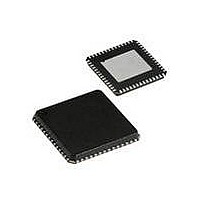CYRF69213-40LFXC Cypress Semiconductor Corp, CYRF69213-40LFXC Datasheet - Page 50

CYRF69213-40LFXC
Manufacturer Part Number
CYRF69213-40LFXC
Description
IC PROC 8K FLASH 40VQFN
Manufacturer
Cypress Semiconductor Corp
Series
CYRFr
Type
Transceiverr
Datasheet
1.CYRF69213-40LFXC.pdf
(77 pages)
Specifications of CYRF69213-40LFXC
Package / Case
40-VQFN Exposed Pad, 40-HVQFN, 40-SQFN, 40-DHVQFN
Frequency
2.4GHz
Data Rate - Maximum
1Mbps
Modulation Or Protocol
ISM
Applications
General Purpose
Power - Output
4dBm
Sensitivity
-97dBm
Voltage - Supply
4 V ~ 5.5 V
Current - Receiving
23.4mA
Current - Transmitting
36.6mA
Data Interface
PCB, Surface Mount
Memory Size
8kB Flash, 256B SRAM
Antenna Connector
PCB, Surface Mount
Operating Temperature
0°C ~ 70°C
Operating Frequency
2497 MHz
Operating Supply Voltage
2.5 V or 3.3 V
Maximum Operating Temperature
+ 70 C
Minimum Operating Temperature
0 C
Mounting Style
SMD/SMT
Operating Temperature (min)
0C
Operating Temperature (max)
70C
Operating Temperature Classification
Commercial
Operating Supply Voltage (min)
1.8V
Operating Supply Voltage (typ)
2.5/3.3V
Operating Supply Voltage (max)
3.6V
Lead Free Status / RoHS Status
Lead free / RoHS Compliant
For Use With
770-1001 - ISP 4PORT CYPRESS ENCORE II MCU
Lead Free Status / Rohs Status
Lead free / RoHS Compliant
Other names
428-1934
Available stocks
Company
Part Number
Manufacturer
Quantity
Price
Part Number:
CYRF69213-40LFXC
Manufacturer:
CYPRESS/赛普拉斯
Quantity:
20 000
Interrupt Processing
The sequence of events that occur during interrupt processing is
as follows:
Table 70. Interrupt Clear 0 (INT_CLR0) [0xDA] [R/W]
Document #: 001-07552 Rev. *D
1. An interrupt becomes active, either because:
2. The current executing instruction finishes.
3. The internal interrupt is dispatched, taking 13 cycles. During
4. Program execution vectors to the interrupt table. Typically, a
5. The ISR executes. Note that interrupts are disabled because
Bit #
Field
Read/Write
Default
When reading this register,
0 = There’s no posted interrupt for the corresponding hardware
1 = Posted interrupt for the corresponding hardware present
Writing a ‘0’ to the bits clears the posted interrupts for the corresponding hardware. Writing a ‘1’ to the bits and to the ENSWINT
(Bit 7 of the INT_MSK3 Register) posts the corresponding hardware interrupt
a. The interrupt condition occurs (for example, a timer expires).
b. A previously posted interrupt is enabled through an update
c. An interrupt is pending and GIE is set from 0 to 1 in the CPU
d. The GPIO interrupts are edge triggered.
a. The MSB and LSB of Program Counter and Flag registers
b. The PCH, PCL, and Flag register (CPU_F) are stored onto
c. The CPU_F register is then cleared. Because this clears the
d. The PCH (PC[15:8]) is cleared to zero.
e. The interrupt vector is read from the interrupt controller and
this time, the following actions occur:
LJMP instruction in the interrupt table sends execution to the
user's Interrupt Service Routine (ISR) for this interrupt.
GIE = 0. In the ISR, interrupts can be re-enabled if desired by
setting GIE = 1 (care must be taken to avoid stack overflow).
of an interrupt mask register.
Flag register.
(CPU_PC and CPU_F) are stored onto the program stack
by an automatic CALL instruction (13 cycles) generated
during the interrupt acknowledge process.
the program stack (in that order) by an automatic CALL
instruction (13 cycles) generated during the interrupt
acknowledge process.
GIE bit to 0, additional interrupts are temporarily disabled
its value placed into PCL (PC[7:0]). This sets the program
counter to point to the appropriate address in the interrupt
table (for example, 0004h for the POR/LVD interrupt).
GPIO Port 1
R/W
7
0
Sleep Timer
R/W
6
0
INT1
R/W
5
0
GPIO Port 0
R/W
4
0
Interrupt Latency
The time between the assertion of an enabled interrupt and the
start of its ISR can be calculated from the following equation.
Latency = Time for current instruction to finish + Time for internal
interrupt routine to execute + Time for LJMP instruction in
interrupt table to execute.
For example, if the 5 cycle JMP instruction is executing when an
interrupt becomes active, the total number of CPU clock cycles
before the ISR begins would be as follows:
(1 to 5 cycles for JMP to finish) + (13 cycles for interrupt routine)
+ (7 cycles for LJMP) = 21 to 25 cycles.
In the example above, at 24 MHz, 25 clock cycles take 1.042 μ s.
Interrupt Registers
The Interrupt Registers are discussed it the following sections.
Interrupt Clear Register
The Interrupt Clear Registers (INT_CLRx) are used to enable the
individual interrupt sources’ ability to clear posted interrupts.
When an INT_CLRx register is read, any bits that are set
indicates an interrupt has been posted for that hardware
resource. Therefore, reading these registers gives the user the
ability to determine all posted interrupts.
6. The ISR ends with a RETI instruction which restores the
7. Execution resumes at the next instruction, after the one that
Program Counter and Flag registers (CPU_PC and CPU_F).
The restored Flag register re-enables interrupts, because GIE
= 1 again.
occurred before the interrupt. However, if there are more
pending interrupts, the subsequent interrupts are processed
before the next normal program instruction.
SPI Receive
R/W
3
0
SPI Transmit
R/W
2
0
INT0
R/W
1
0
CYRF69213
POR/LVD
Page 50 of 77
R/W
0
0
[+] Feedback











